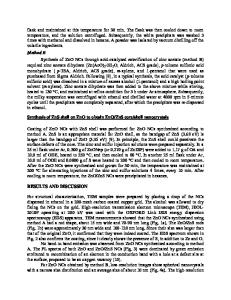Intramolecular Heterocyclization of o -(1-Cycloalkenyl)anilines: III. Synthesis of Optically Active 4 H -3,1-Benzoxazine
- PDF / 271,323 Bytes
- 9 Pages / 612 x 792 pts (letter) Page_size
- 97 Downloads / 261 Views
amolecular Heterocyclization of o-(1-Cycloalkenyl)anilines: III.1 Synthesis of Optically Active 4H-3,1-Benzoxazines Based on α-Amino Acids Sh. M. Salikhova,*, R. R. Zaripovb,**, and I. B. Abdrakhmanova a
Ufa Institute of Chemistry, Ufa Federal Research Center, Russian Academy of Sciences, Ufa, 450054 Russia b
Bashkir State Agrarian University, Ufa, 450001 Russia
e-mail: *[email protected]; **e-mail: [email protected] Received June 8, 2020; revised June 19, 2020; accepted June 26, 2020
Abstract—A new approach has been proposed to the synthesis of optically active 4H-3,1-benzoxazine derivatives based on α-amino acids. The target products have been obtained by reaction of o-(cyclopent-1-en-1yl)aniline with N-Boc-protected amino acids, followed by removal of the protecting group and heterocyclization by the action of dry hydrogen chloride in methylene chloride. Keywords: 3,1-benzoxazines, o-(cyclopent-1-enyl)aniline, α-amino acids, intramolecular heterocyclization
DOI: 10.1134/S1070428020090183 It is known that benzoxazines exhibit various pharmacological and biological activities [1–6]. Some benzoxazine derivatives are used in medicine as anticonvulsants and antiviral agents; they also show tranquilizing, analgesic, spasmolytic, and sedative properties in combination with low toxicity [7–11]. We previously developed a simple procedure for the synthesis of 3,1-benzoxazines and 3,1-benzothiazines from o-(cyclopent-1-en-1-yl)aniline (1), the product of amino-Claisen rearrangement, and studied in detail the mechanism of formation of such compounds in gas and condensed phases [12–18]. In recent time, hybrid multifunctional agents that are combinations of two pharmacophores in a single molecule have attracted much interest from medicinal chemists. Amino acids have been frequently used as an additional pharmacophore [19–21]. Syntheses of 3,1-benzoxazines from natural α-amino acids have not been reported. In the present work we used N-phthaloyl (Phth)- and N-tert-butoxycarbonyl (Boc)-protected optically active α-amino acids, namely (R)-valine, (R)-norleucine, (R)-leucine, and (R)-methionine, to obtain 3,1-benzoxazine derivatives modified with amino acid residues. Initially, phthalic anhydride was fused with α-amino acids according to the procedure described in [22], and the subsequent treatment with 1
For communication II, see [1].
thionyl chloride gave acid chlorides (R)-2a–(R)-2d. The reaction of (R)-2a–(R)-2d with o-(cyclopent-1-en1-yl)aniline (1) in the presence of potassium carbonate, followed by treatment of the reaction mixture with 10% aqueous NaHCO3, led to the formation of optically active amides (R)-3a–(R)-3d (Scheme 1). Enantiomeric purity of the products was not determined. Hydrogen chloride, trifluoroacetic acid, and hydrogen peroxide were tried as electrophiles to effect intramolecular heterocyclization of amides 3a–3d. However, in no case were target 3,1-benzoxazines 4 formed, which may be due to electronic effect of the phthaloyl protecting group. We succeeded in obtaining 3,1-benzoxazine derivatives after
Data Loading...











